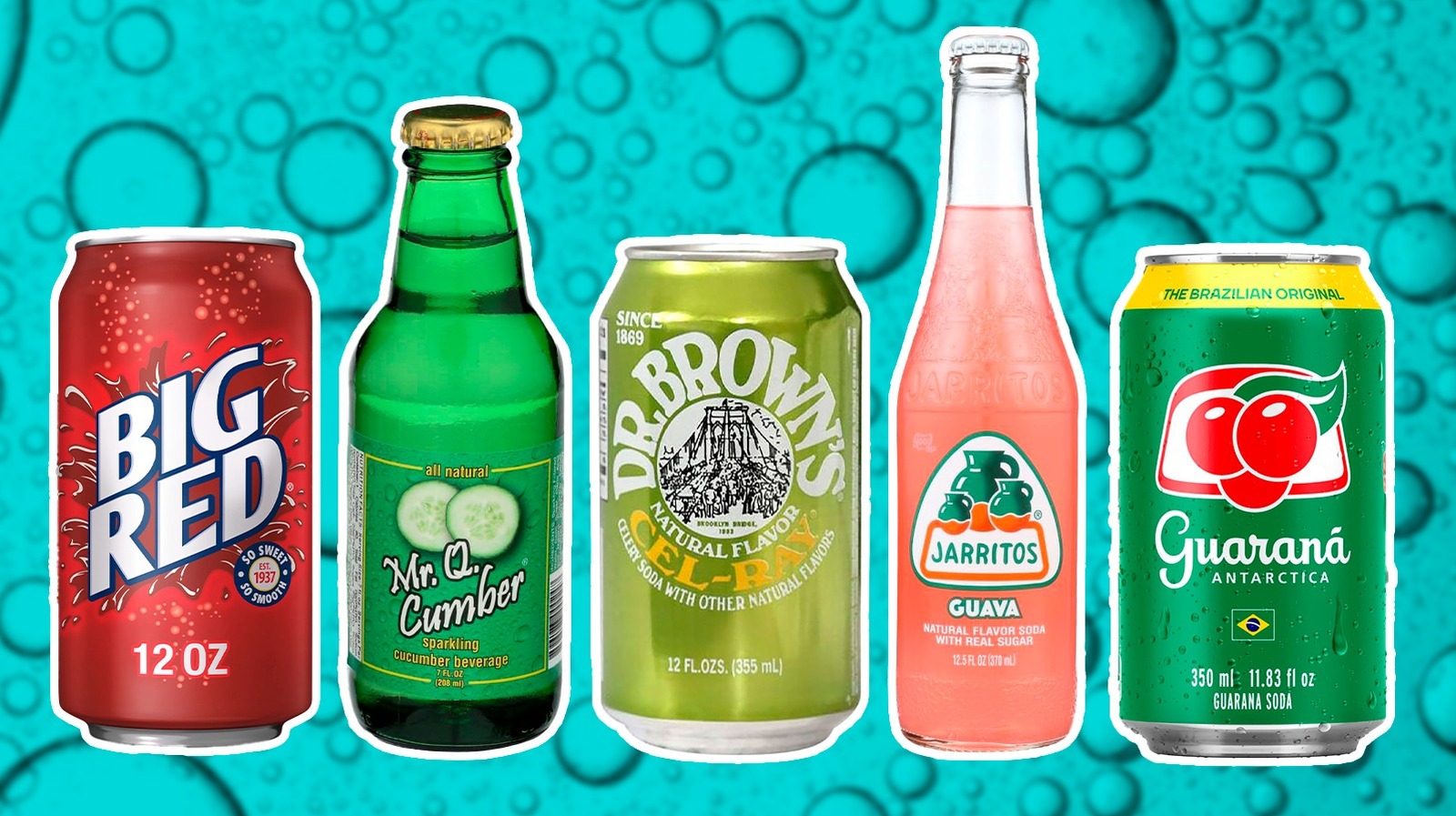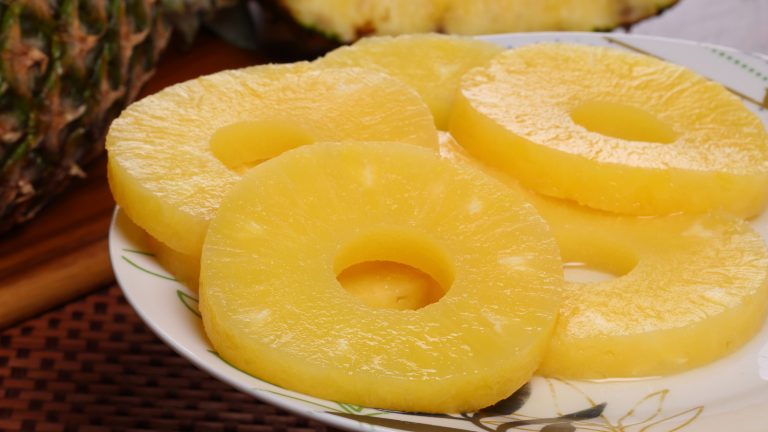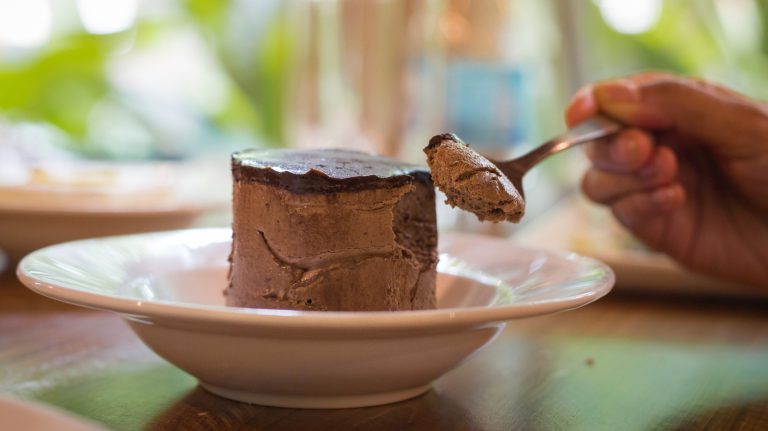We may receive a commission on purchases made from links.
The soda market is oversaturated with dark colas, like Pepsi and Dr. Pepper, and citrus-forward flavors, like Mountain Dew and Fanta. But behind the biggest names lies a host of unusual gems that experiment with bold flavors in a can or bottle. Some started as health fads and have transformed into regional favorites with rich histories. Others play with unique flavor profiles using tropical fruits, vegetables, and even the flavor of spruce trees.
The first soda ever invented tastes nothing like the cans of Coca-Cola or Sprite that we slurp on today. Joseph Priestley, a U.K. chemist, was the pioneer who originally added bubbles to spring water in 1767, thus creating what we now know as soda, pop, or soft drinks. The once tasteless bubbly beverage has evolved into a running list of flavors that fill up entire vending machines, aisles at the grocery store, and mixers behind a bar. Soda brands have taken Priestley’s original recipe to a whole new level, with some infusions stranger than others if you like to sip adventurously. The next time you crack open a cold one, consider guzzling one of these 11 strange soda flavors that are off the beaten path.
1. Dr. Brown’s Cel-Ray Soda
Would you reach for a can of celery juice? Dr. Brown perfected a formula to recreate the earthy flavor in every sip of this fizzy drink. This celery-flavored soda was initially invented in New York City and inspired by Dr. Brown’s celery tonics that were thought to aid digestion. Celery has been used as medicine for centuries, but even though Dr. Brown’s Cel-Ray Soda only contained the seeds of the vegetable, he leveraged the purported health benefits to market his new creation.
Dr. Brown’s Cel-Ray soda was introduced in 1868 and became a signature drink at Jewish delis around the Big Apple. This partnership made it outlast other options on the market that died down after the celery health fad, including Celery-Cola from the creators of Coca-Cola. Dr. Brown’s Cel-Ray soda is sweet, like ginger ale, but with a peppery pinch from the celery seeds, making it a perfect complement to deli favorites like pastrami and Reuben sandwiches.
2. Moxie
Soda was thought to be medicinal in the 19th and early 20th centuries, and many soda shops were first set in drug stores, where soda water was prescribed for upset stomachs, indigestion, and headaches, among other ailments. Moxie was no exception, as it was first marketed as a solution for nerves when Dr. Augustin Thompson, a Maine native, introduced it in 1876.
Moxie, the longest continuously produced soda in the U.S., is a bitter soft drink with notes of black licorice. The cult-favorite soda is flavored with a gentian root extract, which is used in bitters and digestives like Aperol and Campari, and gives the beverage a pungent taste. It’s been likened to root beer for its wintergreen-like aftertaste, and is sweetened with pure cane sugar or high fructose corn syrup, depending on production. Maine claimed Moxie as the state’s official soft drink in 2005, and the New England favorite reached an even wider audience when Coca-Cola bought it in 2018, sharing Thompson’s legacy with the world.
3. Mr. Q. Cumber
Mr. Q. Cumber is like spa water with a hint of carbonation. The refreshing soda mixes natural cucumber extract with sugar cane and sparkling water for a subtle caffeine-free gulp. Despite being derived from cucumber, it has a similar fruity taste to Sprite, but with no artificial flavors, colors, or sweeteners. Sprite uses ingredients like high fructose corn syrup, citric acid, sodium citrate, and sodium benzoate to create its tongue-tingling flavor. Not to mention, Mr. Q. Cumber only has 90 calories in a 7-fluid-ounce bottle, compared to Sprite’s 192 calories in a 12-fluid-once can, making it a healthier alternative.
Florida-based Global Beverage Enterprises first introduced the sparkling cucumber beverage in 2009, selling it in a green glass bottle. Mr. Q. Cumber works well as a mixer if you’re looking for a refreshing summer cocktail. Stir it into your favorite clear liquor, like tequila, gin, or vodka with a cucumber garnish, or use it to make a Pimm’s Cup for an easy pick-me-up.
4. Empire Spruce Beer
If you’re drawn to the smell of Christmas trees, you’re going to be merry about this root beer flavored with an extract made from spruce needles. Empire Spruce Beer bottles the memory of chopping down your own evergreen conifer for the holidays. The Rhode Island-based soda was inspired by the indigenous North Americans and explorers, who boiled Canadian spruce needles to use as a medicine for scurvy, a debilitating vitamin C deficiency. It was especially popular among military members when fresh fruit and vegetables were not available. Spruce needles are a good source of vitamin C, but they are diluted when fermented, so the beer likely had no real medicinal properties.
Although the original spruce-flavored drink started off as a true beer, the soda contains no alcohol. The modern-day version is popular in Canada and can be challenging to find in the United States, much like hunting for the perfect Christmas tree. Thankfully, Empire Brewing Works offers a stateside option in specialty stores and online.
5. Lester’s Fixins’ Bacon Soda with Chocolate
If you really want to get weird with flavors, Lester’s Fixins offers a bacon soda with chocolate. The sweet and savory drink was born out of Rocket Fizz, a franchise of candy stores that started in Camarillo, California. Rocket Fizz co-founders Rob Powells and Ryan Morgan launched the strange-flavored soft drinks brand, naming it after Morgan’s grandfather, Lester. The chocolate bacon soda tastes like a greasy slice of the breakfast favorite with sweet hints of milk chocolate. Get a taste of the pork-flavored drink at any of the 100 Rocket Fizz locations around the U.S. or Canada. A Denver Rocket Fizz franchisee said it’s the most popular flavor at the store and tastes exactly like a crisp piece of bacon fresh off the griddle.
From bacon to mustard-flavored soda, Lester’s Fixins hasn’t met a flavor that it hasn’t tried carbonating. If you want to take your taste buds on an adventure, you can slurp down an assortment of flavored carbonated beverages, like sweet corn, ranch dressing, pumpkin pie, or pickle. The food-forward sodas are basically a meal in a can.
6. Big Red
Texas’ signature soda tastes like chewing a glob of Hubba Bubba bubblegum on a hot summer day. Big Red originated in Waco, Texas, in 1937, under the name Sun Tang Red Cream Soda. Its present-day name was inspired by a golf caddy, who referred to the Sun Tang Red Cream soda as “big red.” The bright red cream soda is a rite of passage for Texans and a staple at Lone Star barbecue joints. Condensation rolls down the cans on hot Texan days, while the drink balances out the saltiness and fattiness of the smoky brisket or spicy sausage on your plate.
The drink has been referenced in a Joe Tex song and featured on the cover of Sir Douglas Sahm’s 1971 album. Big Red is made with plenty of sugar and displays hints of lemon, orange, and vanilla, ensuring every gulp is as sweet as the last. Since the color is reminiscent of a strawberry soda, newbies are often surprised by the initial creaminess.
7. Avery’s Unicorn Yack
Don’t let Avery’s off-putting name for its bright purple soda deter you from enjoying the blend of raspberry and orange cream. Avery’s is one of the oldest soda bottling companies and started carbonating drinks out of a red barn in New Britain, Connecticut, in 1904. The small-batch craft sodas are still made in the same red barn that founder Sherman F. Avery worked out of over 100 years ago.
The tartness from the raspberry and orange cream puckers your lips like a pack of Skittles, and the playful violet hue mimics the magic of unicorns. Avery’s Unicorn Yack soda is part of the company’s Totally Gross soda line, which features flavors that embrace the 10-year-old kid in all of us. While the names are sure to make you do a double-take, the flavors will keep you sipping for more, like the kiwi-pineapple Bug Barf, pink passionfruit and lime Fungal Fruit, or strawberry and orange Zombie Brain Juice.
8. Sangaria Ramune’s Lychee soda
In Japan, ramune is a carbonated drink famous for its specialty packaging in a Codd-neck glass bottle that’s sealed at the top with a marble. It started off as a carbonated lemonade when Alexander Cameron Sim, a pharmacist living in Nagasaki, Japan, first created it in 1884. The CO2 from the carbonation seals the marble on the rubber ring cap, acting like a cork to avoid a flat soda. Each one has a plunger topper that pushes the marble into the bottle and releases the pressure before your first sip. The drink has become synonymous with summer festivals in Japan and is a fun experience for kids and marble collectors alike.
Sangaria Ramune has expanded beyond the original lemonade flavor and infuses real fruit juices into the beverages, including strawberry and lychee. If you’ve ever ordered a lychee martini or like to eat canned lychees, you’ll love a swig of the fizzy floral Japanese import.
9. Guaraná Antarctica
Contrary to the name, Guaraná Antarctica is actually Brazil’s favorite drink. The soda is made from the seeds of guarana fruit, which has twice the amount of caffeine of coffee beans. Guarana naturally reduces fatigue and enhances cognitive function. For centuries, Brazilian Indians have been eating the red Amazonian berry for an extra boost, and it has since evolved into a main ingredient in energy drinks like Redbull or Monster.
Guaraná Antarctica patented the recipe for the wake-up call in a can in 1921. The thick soda masks the bitterness of the fruit with sweet notes of apple and berries. In Brazil, the drink is as common as Coca-Cola is in the United States, served at restaurants and sold at markets throughout the country. Despite the stimulating fruit, Guaraná Antartica has a little less caffeine and sugar than Coca-Cola, which even made its own version of the drink called Kuat that was recently discontinued.
10. Jarritos Guava soda
Jarritos, one of Mexico’s earliest soft drinks, bottled the perfect meld of sweet and sour with its guava soda. The brand has never been one to shy away from the unusual, given that founder and chemist Francisco Hill started the company out of his home in 1950 with a coffee-flavored fizzy beverage. Named after the clay water jug that the bottle resembles, Jarritos rivals the cult-favorite Mexican Coke with its array of tropical carbonated options and vibrant labels. You can typically find the bottles at taco trucks, Mexican restaurants, or bodegas.
Jarritos uses real fruit and cane sugar to mimic a juicy bite of guava, mandarin, lime, passionfruit, strawberry, or tamarind. Guava, a high-protein fruit native to Mexico, is often mixed into flans, made into a paste to serve with cheese for dessert, or stuffed into traditional pinatas with candies around the holidays. A bottle of guava Jarritos is like sipping on Mexico’s traditional Christmas fruit punch, ponche navideno.
11. Calpico Soda
Milk and soda might seem like an odd combination, but Calpico experiments with the flavors from the Japanese brand’s original creamy drink in bubbly form. Calpico, also known as Calpis in Japan, is a fermented milk drink that Kaiun Mishima created in the early 1900s as a gut-healthy option. It’s made with the company’s trademarked Calpis bacteria, which consists of lactobacilli and yeasts. Calpico was the first drink on the market with lactobacilli, which produces lactic acid and helps digestion. Over the last 100 years, the milky beverage, similar to sippable yogurt, has become one of Japan’s best-selling drinks and is now sold in more than 25 countries. Calpico has a line of non-carbonated, milk-based flavors, including peach, lychee, mango, and strawberry.
The Japanese brand later introduced a carbonated version of its popular probiotic product to appeal to soda lovers around the world. Calpico soda is made with cultured milk and the company’s proprietary lactic acid bacteria, which gives it a sweet and tangy aftertaste.





